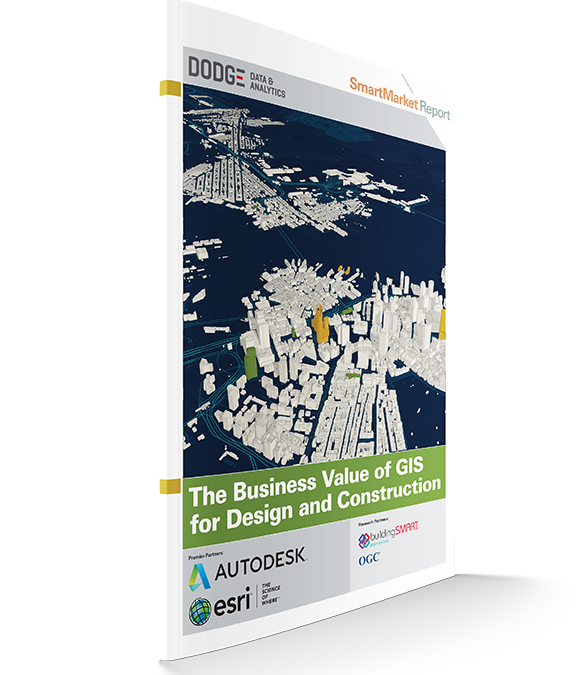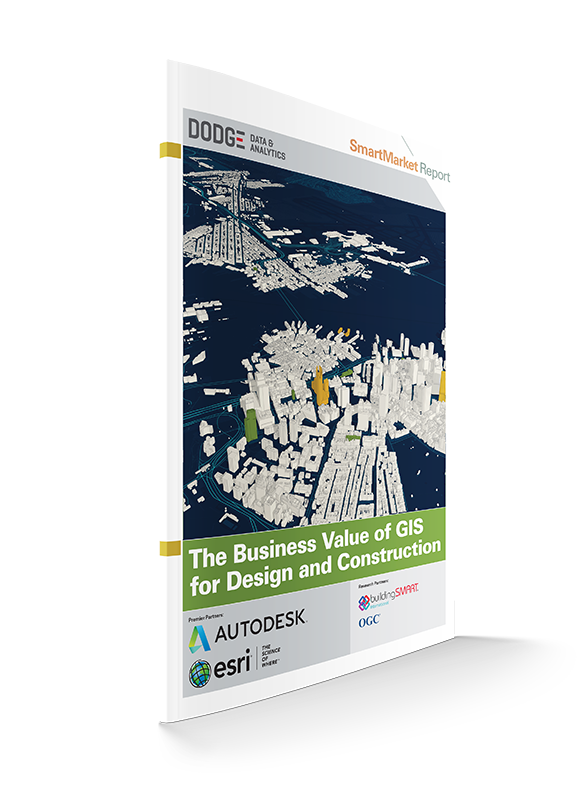

GIS is a critical part of the digital revolution in the design and construction industry, according to the findings of a new study, The Business Value of GIS for Design and Construction SmartMarket Report, released today by Dodge Data and Analytics. The new research, funded by Esri and Autodesk, shows that use of GIS is continuing to grow in the industry as design and construction companies increasingly take advantage of its datasets and tools to improve their projects and grow their businesses.
The study surveyed those with experience with using GIS, and it explores exactly how they are using it. The findings reveal that the following activities are used by over 50% of designers and over 40% of contractors on over half of their projects:
- Designers: project planning and permitting, classifying land use, buildings, highway and infrastructure
- Contractors: site data collection, and to provide digital handovers of project information
However, the findings also demonstrate that the industry is just starting to tap the potential of the data itself, with many high-value GIS activities — such as the use of demographic and socioeconomic data, field data collection, monitoring the location and usage of materials and equipment, and to improve safety and security — used by less than one-third of the respondents on the majority of their projects.
The study also reveals the benefits that practitioners gain from their use of GIS. Nearly all (88% or more) of GIS users report that they have experienced important improvements in their project processes and outcomes, reduced risk, better sustainable performance and business benefits both internally and market-facing. Some of the benefits of GIS use recognized as important by over 50% of GIS users include improved productivity, increased client satisfaction, the ability to offer more services to the industry, and reductions in conflicts and coordination problems onsite.
The study also shows that GIS data is most valuable when it is used by the entire project team, rather than in isolation. Both designers and contractors find that the use of GIS by the design team offers the greatest value to the project, but many designers also consider owner engagement with GIS important. “This study reinforces how the digital transformation of our industry is focusing on changing processes as much as it is about adopting various technologies,” says Steve Jones, senior director of industry insights, Dodge Data & Analytics. “Use of GIS provides another way for teams to engage more fully in the project together and improve project outcomes for everyone, just as we have seen in many of our other technology studies.”
To support the ability to engage the entire project team with the use of the data and to gain more from its use, some of the top challenges to using GIS data will need to be fully addressed. The biggest challenge reported by GIS users in the study is the lack of interoperability with other tools, and many note that more staff with the ability to manage GIS is essential. To help address this, Autodesk and Esri are joining forces to integrate GIS and BIM, unlocking insights and efficiencies for all project team members and stakeholders.
Despite these challenges, all the findings of the study suggest that the use of GIS is likely to grow in the design and construction industry. In addition to the positive perspectives on the value of GIS among the users surveyed, the findings also included insights from a small sample of non-users, and the results suggest that use of GIS is likely to grow:
- 87% of non-users have a positive outlook in GIS, from being open to exploring its value for their company to actively evaluating it.
- Based on the user findings, it is likely that non-users underestimate the use of GIS by their competitors, which may create competitive pressure for wider adoption.
- Especially among designers, some of the top business benefits that would influence their decision to use GIS in the future—improved productivity and improved client satisfaction—are among the top benefits reported by GIS users.
In addition to the survey findings, the Business Value of GIS for Design and Construction SmartMarket Report also features two case studies on the use of GIS and several feature articles, including how GIS is being used to improve sustainability and resiliency and how it is an essential component of Smart Cities. The report can be downloaded for free at www.construction.com/toolkit/reports.
